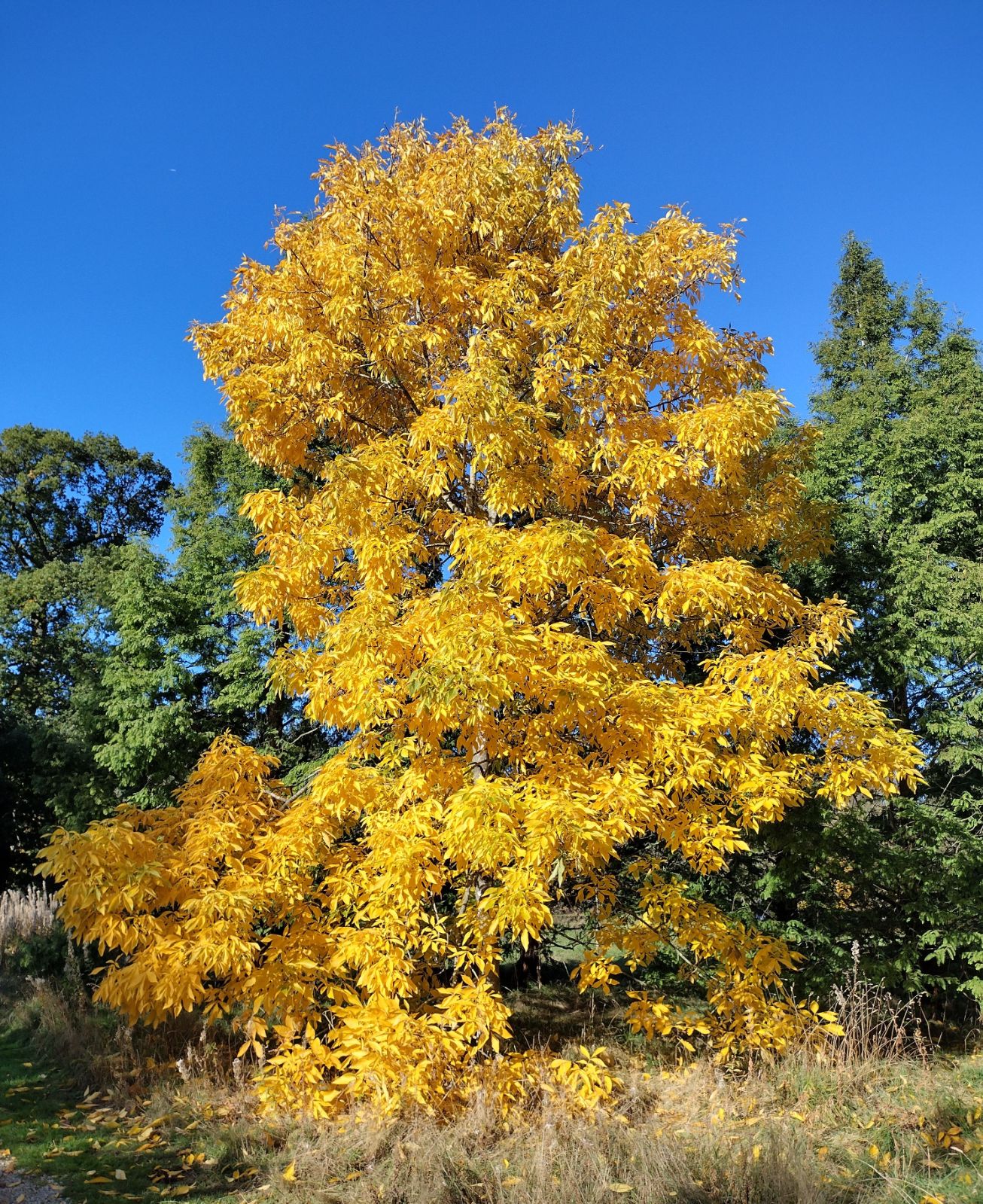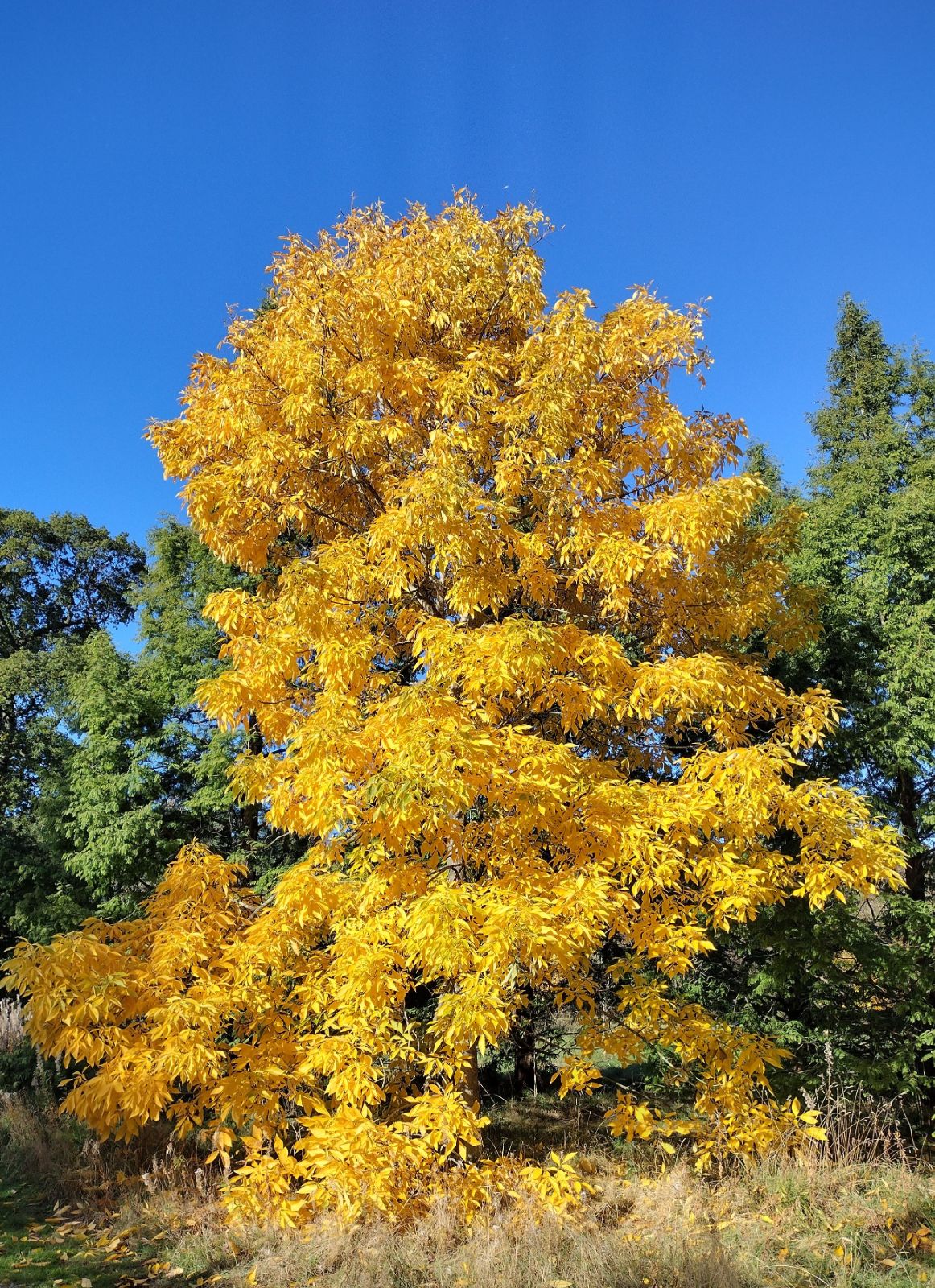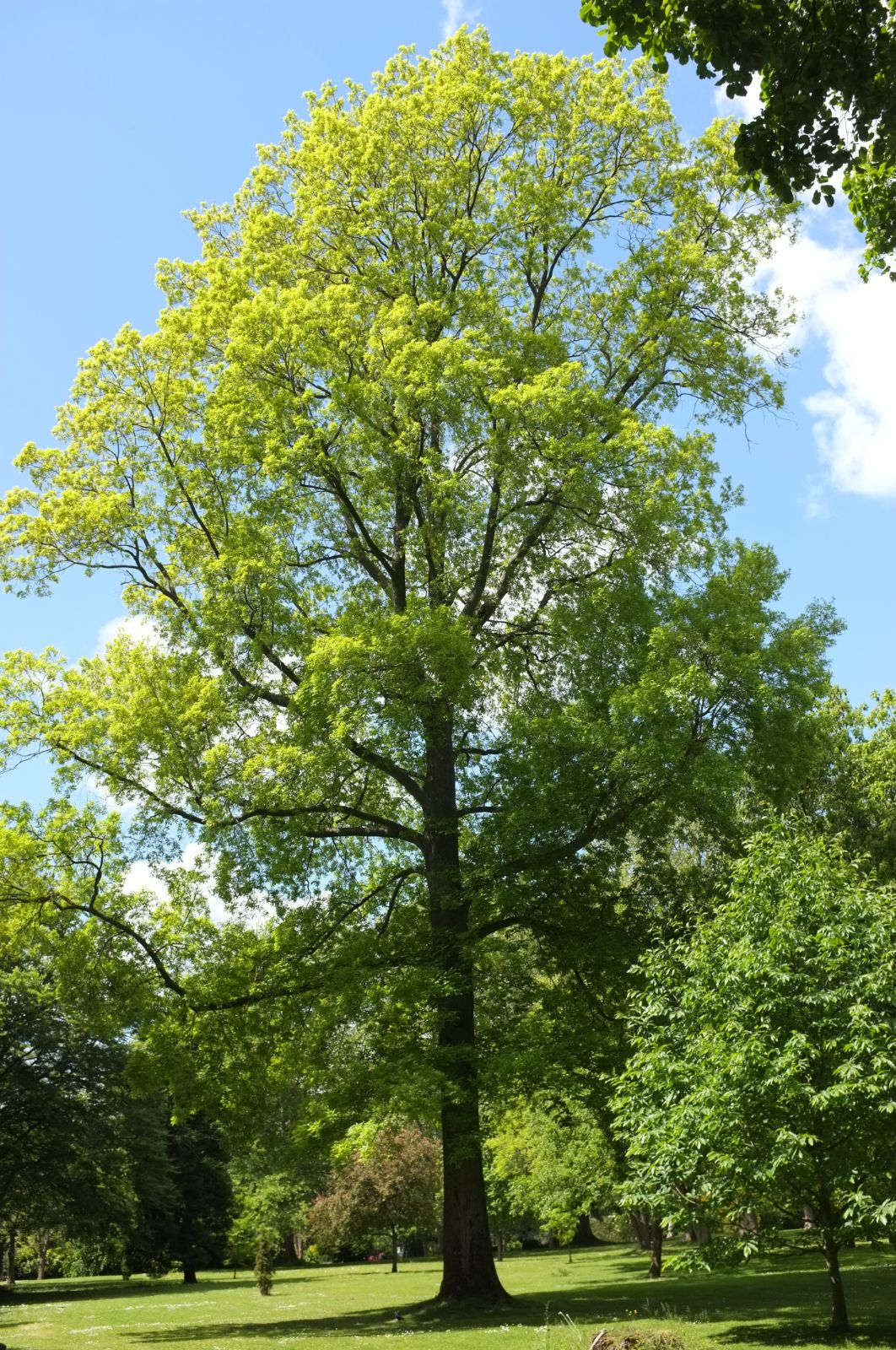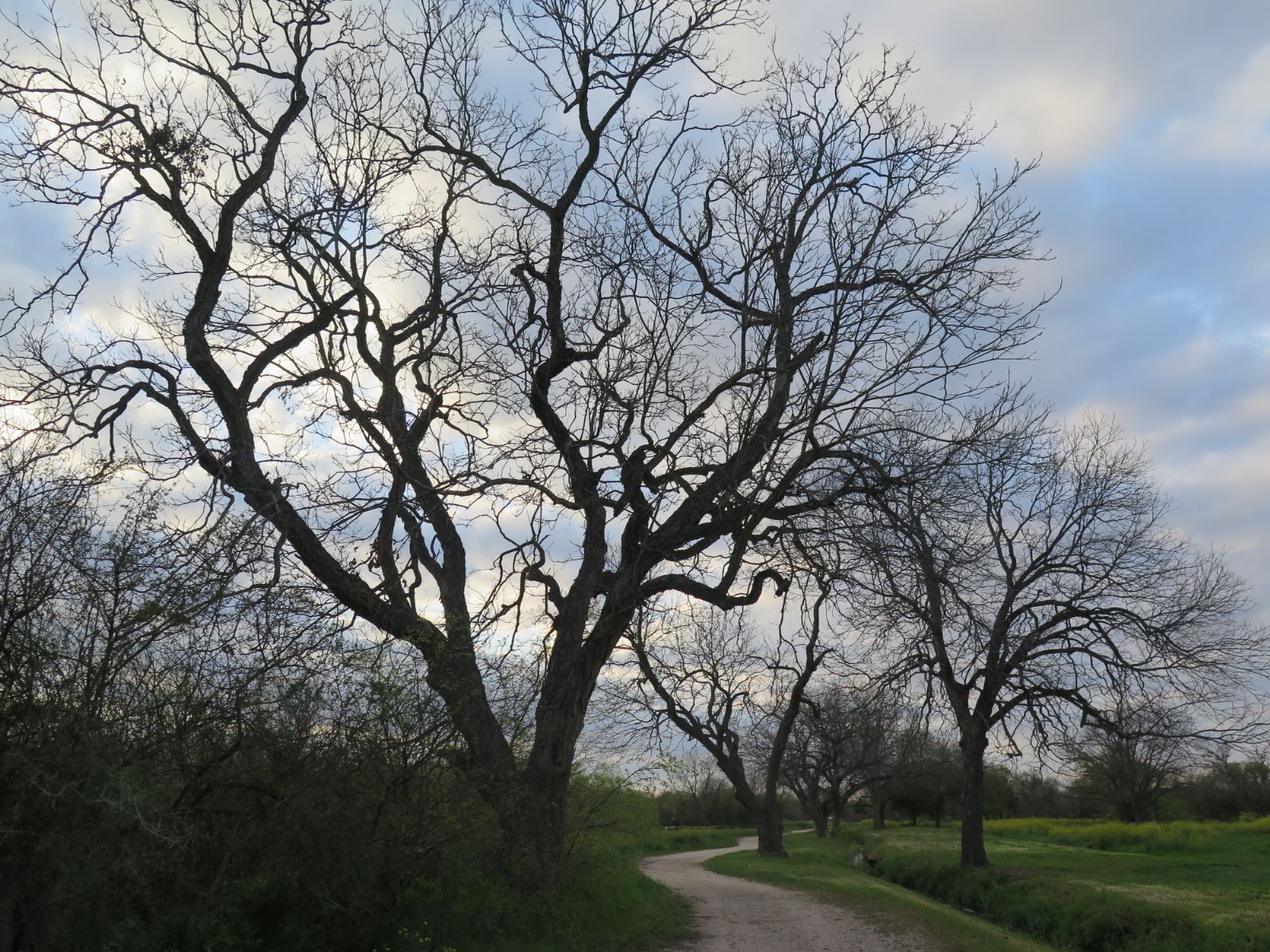Carya
Sponsor
Kindly sponsored by
a member of the International Dendrology Society
Credits
Julian Sutton & Dan Crowley (2020)
Recommended citation
Sutton, J. & Crowley, D. (2020), 'Carya' from the website Trees and Shrubs Online (treesandshrubsonline.
Family
- Juglandaceae
Common Names
- Hickories
- Pecans
Synonyms
A genus of about 16 living species, native to temperate regions of eastern North America (incuding Mexico) and East Asia.
Deciduous, monoecious trees, often large; rarely shrubs. Bark grey to brown, smooth with some fissures in young trees, becoming deeply furrowed or breaking into plates or strips with age. Bark often has identification value in Carya, though it is usually absent from herbarium specimens. Terminal buds naked, or protected by valvate or imbricate scales. Leaves imparipinnate with 3–17(–21) leaflets; leaflet margins serrate, the lower surfaces covered with glandular scales and non-glandular hairs. Inflorescences terminal or axillary, on old or new growth; male catkins axillary, pendulous, in clusters of three at the base of new growth or rarely on old growth; female spikes terminal, erect, on new growth. Male flowers subtended by a bract, with (usually) no sepals and no petals; stamens (2–)3–7(–10). Female flowers subtended by a bract that is fused to the ovary, with no sepals and no petals; stigmatic disk four-lobed. The fruiting spikes are erect; the fruit is a nut, enclosed in a dehiscent, four-valved husk; the nuts may be smooth or pitted (Elias 1972; Stone & Whittemore 1997; Lu et al. 1999).
At their best, hickories are impressive trees. Many have edible nuts and excellent autumn colour, but they are far too little grown and understood outside their native ranges.
Carya was first recognised as a genus by the adventurous English naturalist Thomas Nuttall in The Genera of North American Plants (1818). Some species had already been described in the genus Juglans. In Greek mythology, Carya was a woman turned into a walnut tree by the wine-and-drunkenness god Dionysus. The hickories’ closest relatives are the walnuts (Juglans), the wingnuts (Pterocarya), and a single species each of Cyclocarya and Platycarya (Manos et al. 2007; Mostajeran et al. 2017). Carya is easy to distinguish from Juglans by its solid rather than chambered pith, seen when a twig is split lengthwise, and from these other genera by its wingless fruits containing large, more or less thick-shelled nuts. The recent work of Kozlowski et al. (2018) gives a broad, illustrated overview of the family. Frei (2019) gives a useful treatment (in German) from a Central European viewpoint, with an interesting emphasis on these trees’ place in human culture.
These genera diverged early in the Tertiary period; combined fossil and molecular evidence place the divergence of Carya early, around 66 MYA . During much of the Tertiary the genus’ range was much wider, with Europe as a third centre of diversity, but it was eliminated from Europe and west Asia by the Pleistocene glaciations (Zhang et al. 2013).
Living Carya species fall into three groups. The East Asian hickories (Section Sinocarya) are recognised by their naked buds. Most have distinctive rusty or yellow scales on the buds and stems. One species, C. cathayensis is described here, along with brief notes on four more which are not grown outside Asia. The North American species fall into two groups. The true hickories (Section Carya) have buds with imbricate (i.e. overlapping) bud scales. We describe nine species, all with distributions centred on the south eastern United States. One further species, C. floridana Sargent is very like C. texana, although often shrubby (Stone & Whittemore 1997; Grauke 2003). Endemic to sandy ridges in Florida, it is probably not hardy in our area. All the tetraploid species (2n=64), as well as some diploids (2n-32) belong to this section. The pecan hickories (Section Apocarya) have buds with valvate scales (that is they meet at the margins but do not overlap); sometimes the scales are leaf-like and the buds appear naked. We describe three North American species. A fourth, C. palmeri W.E. Manning, is endemic to northern Mexico; in our area it is grown in the favoured climate of the University of California Botanical Garden, Berkeley (University of California Botanical Garden 2019) and perhaps nowhere else. Molecular data support the distinction between the East Asian and North American hickories (Zhang et al. 2013). No studies to date have been able sufficiently to resolve relationships among the Americans. One species, the rare C. myristiciformis is in many ways intermediate between Sections Carya and Apocarya and sometimes placed in each (Stone & Whittemore 1997; Grauke 2003). Good phylogenetic evidence would be most interesting here.
All species are wind pollinated and have male and female flowers on separate spikes. These tend to mature at slightly different times, and the experience of nut growers is that they are not very self-fertile (Crawford 2016). Some cultivars have been identified as clearly being either protogynous or protandrous in Pecan (C. illinoinensis), but not in other species grown for nuts. In wild C. ovata and C. tomentosa, individual trees can switch between protogyny and protandry from year to year (McCarthy & Quinn 1990). In general, more than one seedling/cultivar should be planted together to ensure pollination.
Seed dispersal is by gravity, with longer distance dispersal provided by rodents and birds. Even the bitter-seeded species are taken by animals to some extent. In pre-industrial times many the nuts of many species were used for food. Even the name ‘hickory’ reflects its use: pawcohiccora (alternative spellings exist) was a liquor or butter made by pulverising the nuts of (probably) C. ovata with water. C. cathayensis has been cultivated in China for around 500 years; in the Americas active cultivation of Carya spp. probably began well after European colonisation. One species, Pecan, is globally traded. In North America the Pecan Weevil (Curculio caryae), whose larvae develop in the nut, is a serious pest of pecans and hickories; as ornamentals they are generally trouble-free.
As a rule, the timber of true hickories is dense, strong and shock resistant. Tool handles, furniture making and firewood are major uses. Historically, it was used routinely in sports equipment – the contemporary term ‘hickory golf’ refers to the game played with ‘retro’ equipment, notably the hickory shafted clubs that were the norm a century ago (Keel 2018). Wood of the pecan hickories is less favoured, but green hickory wood in general is prized for smoking meat.
With a few exceptions, wild hickories are usually found on fertile, well-drained soils in valleys, with at least reasonable moisture availability, in areas with warm, often humid summers. This should guide planting: waterlogged or dry, exposed sites are not ideal.
The under-representation of Carya in European collections seems to be one component of a vicious circle involving lack of supply, difficulties with establishment, cool summers in maritime areas, poor identification, poor representation in accessible literature, and general underappreciation of these trees’ potential. They may be better understood in North America, but supply and establishment issues remain (Dirr 2009).
Apart from the cultivars, propagation is usually from seed. Seed set is poor in areas with cooler maritime climates, such as the United Kingdom, and seed from indigenous populations is ideal. Most species, especially the true hickories, quickly produce a long taproot. This makes conventional field raising and transplantation difficult, with high losses. Bean (1976), growing plants in conventional pots, emphasises the need for planting out when very young. He advises storing ripe seed over winter in boxes of moist soil, (the experienced Dirr (2009) emphasises the need for exposure to cold) then placing the nuts singly in 15 cm pots in early spring, in a slightly heated frame or greenhouse, to be planted out as very small seedlings once the danger of frost has passed. The rise of the AirPot and similar containers should transform the successful cultivation of Carya, enabling good plants to be grown with a fibrous root-mass without disturbance, though even so saplings should not be retained in the containers for longer than necessary. In the American southeast, Dirr (2009) suggests using sowing singly in much larger 11 litre pots and keeping the seedlings, which show little shoot development in the first year, even though the taproot is growing, rather longer in pots. However grown, it is critical that the ungerminated nuts are kept in a rodent-free environment. Establishment can be slow and a tree cage gives useful shelter in the early years. Grafting is possible, normally for cultivars. The rootstock need not necessarily be the same Carya species. For example, The Grimo Nut Nursery in Canada uses ultra-early northern strains of C. illinoinensis as rootstocks for C. ovata cultivars (Society of Ontario Nut Growers 2013).
Mitchell (1974) recognised the identification problem faced in Europe ‘because they are often seen wrongly named and books have failed to make good distinctions, referring in general terms to the nuts’. Acknowledging the issues of variation and hybridity, he went on to provide a key to the five commonest species, intended to work for ‘nearly all trees’. Sadly, when tested on a large, unlabelled collection of hickories, 20–30 years old, at Cockington Court, Devon, it failed to give many convincing identifications; the key in Flora of North America (Stone & Whittemore 1997) proved far more reliable (J. Sutton, pers. obs. 2019). Our own key is modified from this.
Identification key | ||
| 1a | Bud scales absent or valvate, completely covered with yellow peltate scales | 2 |
| 1b | Bud scales imbricate or valvate. Peltate scales, if yellow, not completely covering the bud scales | 3 |
| 2a | Bud scales absent. Underside of leaflets with abundant, persistent, yellow peltate scales. Rare in cultivation outside China | cathayensis |
| 2b | Bud scales valvate. Yellow peltate scales on underside of leaflets less conspicuous and not persistent | cordiformis |
| 3a | Scales of terminal buds valvate; axillary buds protected by pair of valvate bracteoles or by bracteoles fused into hood; leaflets (5–)7–13(–17), symmetric or falcate; husk sutures winged; nuts sweet or bitter, shells thin or thick | 4 |
| 3b | Scales of terminal buds imbricate; axillary buds protected by bracteoles fused into hood; leaflets 3–9, symmetric; husk sutures usually without wings, infrequently with narrow wings (C. floridana, C. glabra, C. texana); nuts sweet, shells thick | 6 |
| 4a | Bark fissured or exfoliating, separating freely into long strips or broad plates; terminal buds ovoid; leaflets (5–)7–9, with dense, persistent covering of peltate scales beneath, bronze; nuts sweet, shells thick | myristiciformis |
| 4b | Bark ridged or exfoliating in long strips or platelike scales; terminal buds oblong; leaflets (5–)7–13(–17), with light to dense covering of peltate scales in spring, becoming moderate to light later, not bronze; nuts bitter or sweet, shells thin. | 5 |
| 5a | Bark exfoliating in long strips or platelike scales; leaflets (5–)9–11(–13), margins serrate to entire; lateral petiolules 0–2 mm; midribs villous beneath near base; nuts bitter, compressed, angled, warty | aquatica |
| 5b | Bark ridged or with appressed scales or exfoliating with small platelike scales; leaflets (7–)9–13(–17), margins serrate; lateral petiolules 0–7 mm; midribs mostly glabrous beneath, rarely hairy near base; nuts sweet, not compressed, not angled, smooth | illinoinensis |
| 6a | Leaflets (3–)5(–7), serrations with hairs tufted below apex, at least some hairs persisting to autumn; bark exfoliating in long strips or broad plates; fruits more or less spherical; husks thick, dehiscing to base | ovata |
| 6b | Leaflets 3–9, serrations sometimes lightly ciliate, subapical tuft absent; bark ridged, often deeply furrowed or exfoliating in strips or plates; fruits spherical to obovoid; husks thin to thick, dehiscing partially or completely to base | 7 |
| 7a | Branchlets stout; terminal buds 8–20 mm; leaflets (5–)7–9(–11), hairy beneath, with abundant unicellular, fasciculate, and multiradiate hairs; husks 4–13 mm thick; nuts strongly angled toward stylar end | 8 |
| 7b | Branchlets slender; terminal buds 3–15 mm; leaflets 3–7(–9), glabrous beneath except near midrib, occasionally hairy with unicellular and fasciculate hairs, never with multiradiate hairs; husks 2–5 mm thick; nuts not strongly angled toward stylar end | 9 |
| 8a | Bark exfoliating in long strips or broad plates; petiole and rachis lightly pubescent; leaflets tapering, acuminate, hairy beneath with abundant unicellular and fasciculate hairs, occasional multiradiate hairs; husks minutely hairy | laciniosa |
| 8b | Bark ridged; petiole and rachis densely hairy; leaflets acute, hairy beneath with sparse unicellular hairs and abundant fasciculate and multiradiate hairs; husks rough, glabrous | tomentosa |
| 9a | Terminal buds 5–15 mm; leaflets (3–)5-7(–9), sparsely to densely covered beneath by small round peltate scales in spring, 4-lobed scales uncommon | glabra |
| 9b | Terminal buds 4–10 mm; leaflets (5–)7(–9), densely covered beneath by small 4-lobed, irregular, and round peltate scales in spring | 10 |
| 10a | Petiole and rachis hairy, with scattered fasciculate hairs and hairs concentrated beneath near leaflet insertions; leaflets with inconspicuous scales beneath, large silvery tan peltate scales dense; mainly east of Mississippi River | pallida |
| 10b | Petiole and rachis with few hairs, hairs not concentrated near leaflet insertions; leaflets with conspicuous small rusty brown scales beneath, large silvery tan peltate scales infrequent; mainly west of Mississippi River | texana |





